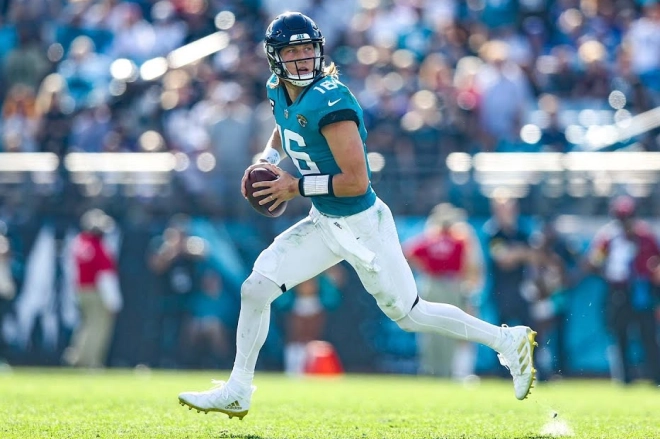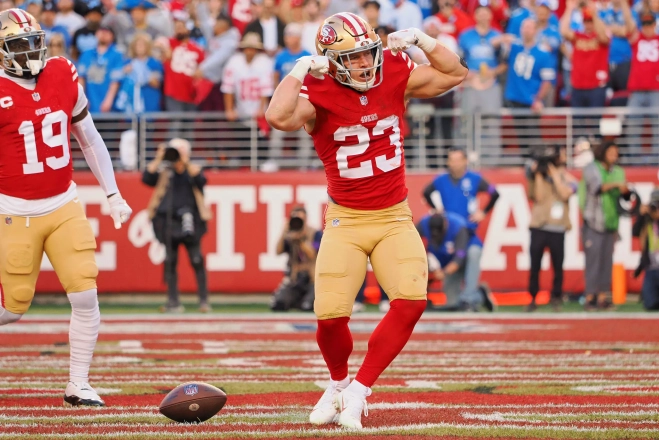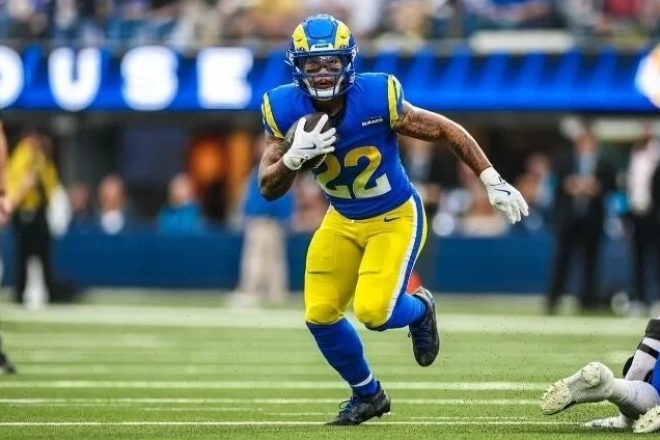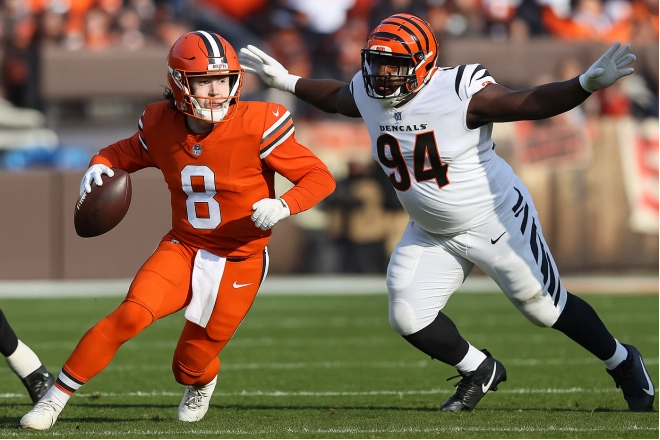My dynasty league had its rookie draft in June, and now we’re in FCFS (first-come, first-served) waiver-mode as training camps open. Real NFL intel is starting to trickle out — who’s on first team, chemistry vibes, injury updates, on and off-field drama.
Many managers remain dormant, waiting to jump-in as late as Week 2 or 3 of preseason. But I see this as a prime opportunity — like the old saying: “The early bird catches the worm.”
A few days ago, I learned Kenny Pickett (QB, Cle) was running with the first team while Joe Flacco sat out. This piqued my interest. I’ve long believed Pickett is NFL starter-caliber, just never landed in the right spot to truly shine. Since his 2022 draft at 20th overall, I’ve kept an eye on him.
After doing my homework, I dropped Kyle Monangai (RB, Chi - R)* for Pickett.
*Note: (R) indicates a rookie player.
My QB room is already fairly stocked: Jalen Hurts (PHI), Bo Nix (Den), Tyler Shough (NO - R).
And my RB depth needs work: Joe Mixon (HOU), Omarion Hampton (LAC - R), Brian Robinson (Wsh), Jerome Ford (Cle), Jayden Blue (Dal - R), DJ Giddens (Ind - R), Devin Neal (NO - R).
How I ended up with so many rookies on my roster is another topic which I cover in The Ultimate Dynasty Draft Strategy - '25.
I like Monangai or he wouldn’t have been on my roster. He’s behind D’Andre Swift (2024: 3.79 yds/carry) and Roschon Johnson (2.99 yds/carry) on the Bears’ depth chart, and I think he might be a better talent than both. Swift, entering his sixth year, is nearing the age when most backs begin to decline (see How To Add An RB1 To Your Dynasty Team - '25), and Johnson isn’t the answer. Monangai has a shot, but Swift remains the Bears’ main back for 2025. If the Bears really felt they needed an RB, they wouldn’t have waited until the 7th round to draft Monangai. And when they do feel they need Swift’s replacement, they will draft a running back earlier in a future draft.
However, the deeper I dug into Pickett and his situation, the more I liked what I saw. His time in Pittsburgh didn’t grab headlines, but he improved every year behind a weak offensive line and a minimal receiving corps. Cleveland offers a better offensive line and receivers.
Yes, Pickett faces stiff competition in Cleveland — Joe Flacco, Shedeur Sanders (R), Dillon Gabriel (R), and Deshaun Watson (currently injured). But I believe Pickett’s mix of experience, character, and youth gives him the edge for 2025.
So, let’s break it down.
The first question is, can Pickett beat the Competition?
The competition:
- Joe Flacco: A seasoned vet at 40 who hasn’t thrown for over 2,000 yards in a season since 2018. Flacco brings experience but likely serves best as a mentor and backup.
- Dillon Gabriel: A third-round QB prospect Cleveland acquired, showing promise but still developing.
- Shedeur Sanders: A rookie with first-round athleticism and skill, but character concerns — on and off the field — contributed to his fall to the 5th round. Early consistency issues persist.
- Deshaun Watson: Currently sidelined with a ruptured Achilles; his status remains uncertain.
Will Pickett win the job? Coaches may not know yet, but he definitely can.
Pickett v Flacco
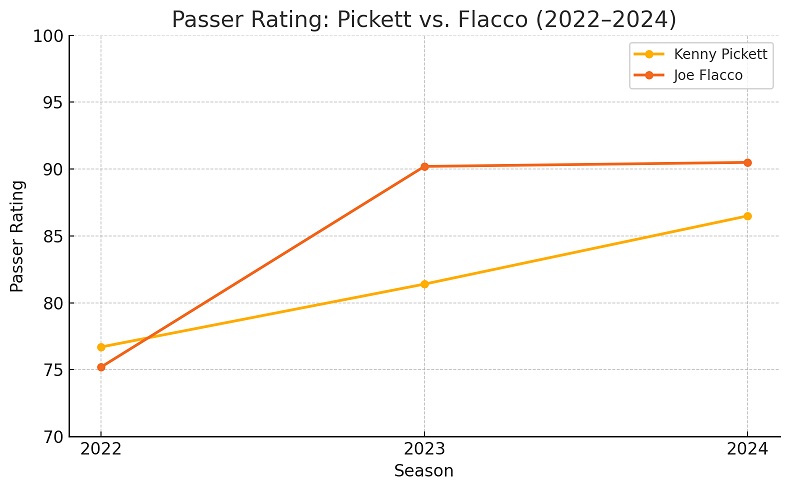
Pickett’s steady improvement narrows the gap with Flacco, despite tougher circumstances. Key advantages Pickett holds:
- Upward performance trend
- Higher future upside
- More favorable salary cap impact
- Opportunity to develop into the team’s long-term QB
Between Pickett and Flacco, Pickett wins hands down. The only way Flacco wins is if Pickett falters — which seems unlikely given Pickett’s professionalism, maturity, and work ethic.
Pickett v Rookies
What About the Rookies?
Camp buzz suggests Gabriel and Pickett are neck and neck after both completing 6 of 7 passes early on. But that’s misleading.
Gabriel’s stats come from a simplified, scripted environment. Real NFL games demand:
- Lightning-fast processing of complex, shifting defenses
- Handling relentless, elite pass rushers
- Leadership under pressure
- Consistency over a long season
Pickett has proven experience in all these areas; Gabriel is still climbing that mountain.
These are key differentiators favoring Pickett:
- Proven mental processing and defensive recognition
- Superior pocket presence and pass-rush handling
- Demonstrated leadership and poise under pressure
- Consistency and durability over multiple starts
While the battle is far from over, Pickett’s experience gives him a meaningful edge heading into the season.
The QB growth curve is roughly three years (see How To Add A QB1 To Your Dynasty Team - '25). Gabriel still has a long road to catch Pickett. The starting job will depend on how coaches project each QB’s development by season’s end, especially considering franchise QB potential.
Sanders remains in the mix but must overcome both consistency and character questions.
Bottom line: Pickett is not a guaranteed starter, but he leads the competition, with others needing to prove significantly more upside early to surpass him.
The second question is, assuming he wins and holds the starting job, what is Pickett's fantasy potential?
Besides Pickett’s steady progress over the last three seasons (with passer ratings climbing from 76.7 → 81.4 → 86.5), the Browns offer a far more favorable environment than Pittsburgh ever did. That opens the door for a potential breakout. Let’s break down why this might be the moment for Pickett to rise.
Offensive Line
Cleveland's offensive line, when healthy, is one of the better units in the league. Veterans like Joel Bitonio and Wyatt Teller anchor a line that offers stability, experience, and protection — something Pickett didn’t consistently enjoy in Pittsburgh. While injuries remain a concern (e.g., Dawand Jones’ recovery and reliance on depth like Teven Jenkins), this group gives Pickett more time in the pocket and increases both his efficiency and potential volume.
Receiving Corps
In contrast to the Steelers’ inconsistent and oft-injured receiver room, the Browns offer Pickett a strong, versatile group of pass catchers. Jerry Jeudy (1,200+ yards in 2024), Amari Cooper, and breakout candidate Cedric Tillman form a well-rounded trio. Add in Harold Fannin Jr., a rookie TE who led the nation in catches (117) and receiving yards (1,555) among tight ends, and Cleveland has the personnel to run effective two-TE sets alongside David Njoku. This group gives Pickett something he’s never had: reliable weapons across the board, with legitimate red-zone threats and big-play potential.
Game Script & Passing Volume
With Quinshon Judkins’ legal status in question and no dominant lead back in the running back room, the Browns could find themselves unable to establish the run — or frequently playing from behind. That means more neutral or negative game scripts, which tend to favor passing volume. Even if the coaches aim for balance, circumstances may force Pickett to air it out. And that’s good news for fantasy.
Fantasy Outlook
Assuming Pickett starts, he is poised for a leap, and there’s precedent for this type of jump. Just look at Jalen Hurts, who went from a passer rating of 89.1 in 2023 to 103.7 in 2024, largely due to improved offensive support. With Cleveland’s infrastructure, a similar breakout for Pickett isn’t far-fetched.
If the offensive line stays healthy and the receivers remain consistent, Pickett could see 400+ pass attempts and a significant uptick in touchdown production. Add in some modest rushing stats, and you’re looking at a quarterback who could finish as a solid QB2 with weekly QB1 upside.
Projected 2025 Stat Line
Passing Yards: 3,800–4,200
Passing TDs: 22–28
INTs: 10–12
Rushing Yards: 150–250
Rushing TDs: 2–4
Estimated Fantasy Points: 320–400 (4-pt/passing-TD scoring)
This puts him in QB1 territory, comfortably startable in 1-QB, superflex or 2-QB formats.
Dynasty Implications
Even if Pickett doesn’t stick as your starter, his value could spike by Week 4 or 5, especially with the typical early-season QB injury attrition (see Quarterback Carousel & Handcuffs). That makes him a perfect buy-low or waiver stash with real potential trade value. You might land a 2026 2nd-round pick or better from a desperate owner needing a starter.
Managing the offseason waiver wire isn’t just about finding starters — it’s about identifying talent with trade potential. Pickett checks both boxes. Like popcorn on a hot skillet, many kernels don’t pop — but the ones that do can win you leagues. This year, Pickett might just be one of them.
I'm not saying you should trade for him or go out of your way to acquire him, but if he is sitting on your FCFS waiver wire, consider if he has more value than another player on your roster and go grab him.
Appendix: Supporting Cast Comparison — Steelers vs. Browns
For readers interested in the specific upgrades Kenny Pickett now benefits from in Cleveland compared to Pittsburgh, here’s a breakdown of both environments:
Offensive Line
Cleveland Browns (2024–2025)
- Joel Bitonio (LG): Pro Bowl-caliber anchor with years of elite play.
- Wyatt Teller (RG): Powerful run blocker, brings consistency inside.
- Dawand Jones (LT): Slimmed-down, athletic, potential breakout if healthy.
- Ethan Pocic (C): Reliable veteran presence at center.
- Teven Jenkins (Depth): Adds experienced versatility to guard/tackle spots.
Strengths:
- More stable and cohesive than Pickett’s former line.
- Stronger pass protection and better run game support.
- Better depth across all positions.
Concerns:
- Injury risk remains (e.g., Jones has missed time).
- Not a top-tier unit league-wide, but clearly improved.
Pittsburgh Steelers (2023–2024)
- Patchwork unit plagued by injuries and inexperience.
- Constant shuffling at tackle and guard disrupted continuity.
- Struggled in both pass protection and run blocking.
Pickett was frequently pressured, rushed, or sacked.
Receiving Corps
Cleveland Browns (2024–2025)
- Jerry Jeudy: Polished WR1, 1,200+ yards in 2024.
- Cedric Tillman: Big-play upside, flashed strong finish last season.
- Amari Cooper: Veteran presence with route-running savvy.
- Diontae Johnson / DeAndre Carter: Solid depth and slot options.
- Harold Fannin Jr. (TE – R): NCAA leader among TEs in catches (117), yards (1,555), and YPG (119.6).
- David Njoku: Athletic TE capable of working the seam and red zone.
Strengths:
- More polished, experienced group than Pickett had in Pittsburgh.
- Two-tight-end sets now a threat with Fannin and Njoku.
- Reliable targets at all depths of the field.
Concerns:
- Cooper’s durability as he ages.
- Lacks a true elite burner, but overall depth is strong.
Pittsburgh Steelers (2023–2024)
- George Pickens: Flashed WR1 traits but battled injuries.
- Chase Claypool: Inconsistent, eventually moved on.
- Supporting cast: rotation of young, unpolished receivers.
- TEs / slot: Minimal impact from tight ends or slot weapons.
Target consistency and separation were major issues.
Comparison Summary
| Aspect | Steelers (2023–24) | Browns (2024–25) |
| Offensive Line | Patchy, injury-prone, inconsistent | Stable core, better depth, improved pass protection |
| Run Game | Najee Harris struggled behind poor blocking | Jerome Ford leads, but may lean pass-heavy |
| Receiving Corps | Young, inconsistent, injury-plagued | More polished, deeper, high-upside options |
| Coaching Stability | OC turnover, offensive identity in flux | Stefanski/Rees provide structure and continuity |
This context helps explain why Pickett may take a leap forward in 2025. He’s entering a system with stronger protection, reliable targets, and a game script likely to lean on the passing game. These are the ingredients fantasy managers should look for when identifying potential QB breakouts.

